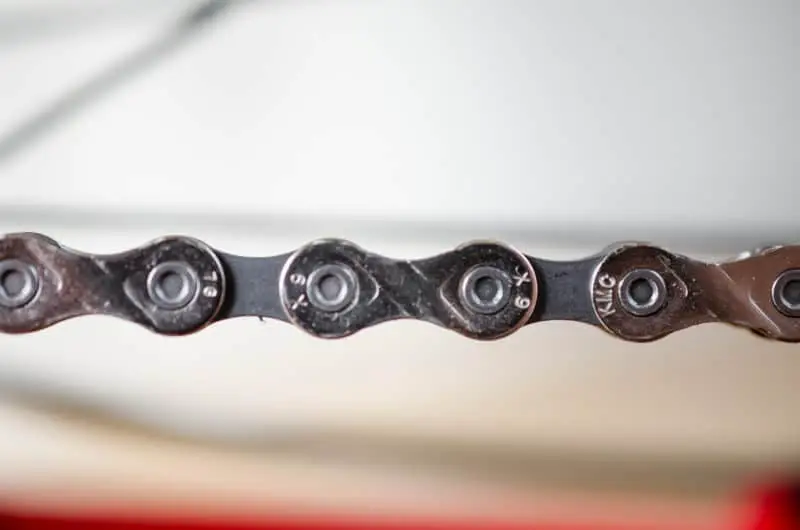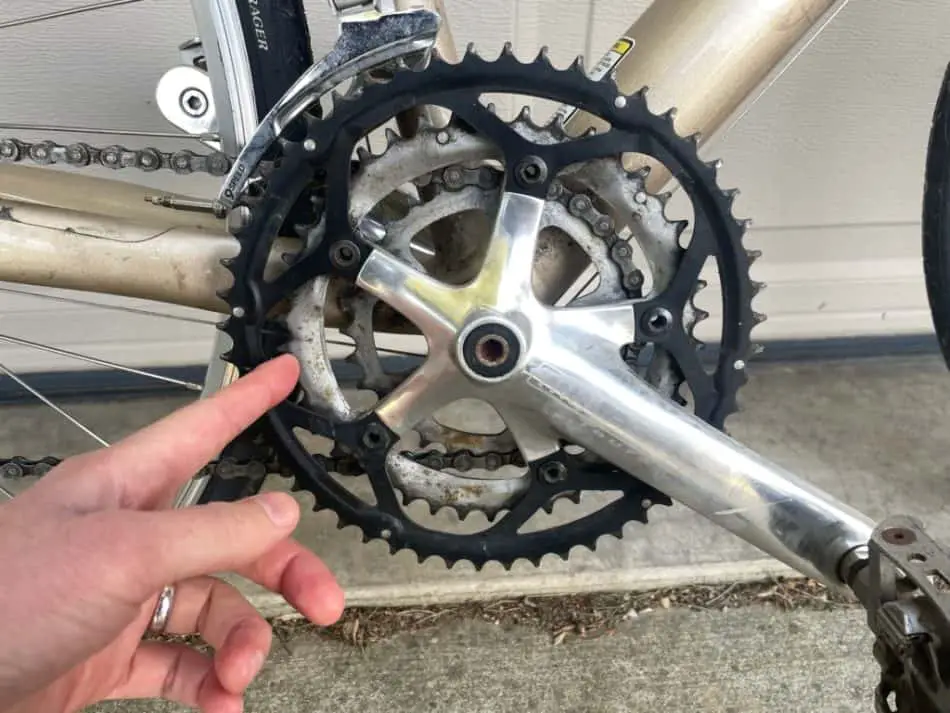With supply chains disrupted, bike parts can be hard to get and expensive to purchase. Bike chains are no different, and it can be hard to find the exact chain you want for your bike. So as I was searching for a spare chain to keep on hand, I started thinking about bike chain quality. Does it matter? Is it worth upgrading my chain? Or is a cheaper chain just fine?
Does The Quality of Bike Chains Matter?
The quality of the bike chain you use will affect chain weight, shifting performance, long-term durability, friction, and shifting noise. A higher-quality chain will be lighter and provide better performance overall. However, the most important factor is choosing a chain that’s compatible with your drivetrain.
In this article, we’ll talk about the advantages of high-quality chains and which riders might benefit from buying one. But first, here are six advantages of high-quality chains.

6 Advantages of High-Quality Chains
1. Weight Savings
One advantage of a more expensive chain is the weight savings. When comparing various models of Shimano chains, the more expensive the chain, the less it weighs.
Single-speed chains are the cheapest but heaviest chains. As the number of speeds in the drivetrain increases, the chain gets thinner because the shifting needs to be more precise to fit between all the cogs on the cassette. Weight differences are more pronounced when you go from a lower quality to mid or high-quality chain, while chains roughly around the same price point vary minimally.
However, compared to the bike’s weight, shaving a few grams off of your chain weight probably won’t make a noticeable difference.
2. Drivetrain Compatibility

Lower-quality chains may only be compatible with a few models of drivetrain. While Shimano’s Nexus is the cheapest of the chains, it’s only compatible with single-speed bikes. So even if you wanted to put a Nexus on your double chainring drivetrain because it costs less, it just wouldn’t work.
Instead, you have to choose a chain that is compatible with your drivetrain. This will affect the cost of the chain because multi-speed chains simply cost more to manufacture than single-speed chains.
3. Durability
High-quality chains are more durable…to a point. According to research conducted by cyclingtips.com, Shimano’s Ultegra chain is more durable than less expensive options. However, Ultegra also seems to be more durable than their premium chain, Dura-Ace. Hmm…
The Ultegra chain has a better coating on the pins and rollers than its less expensive counterparts, which makes it work with less friction. Less friction means less wear over time, resulting in a more durable chain.
4. Less Friction
The higher the chain quality, the better the coating on the links, rollers, and pins. This special coating reduces friction on the chain. Less friction also means less loss of power, and according to Shimano, a chain like the Dura-Ace will save you half a watt over its Ultegra chain (if you are spinning 90 RPMS at 250 watts, though).
The UFO Racing Chain has been specially treated to enhance performance. As a result, this chain boasts an extra two to five watts over the course of 600km…but it will cost you more than 3x the price of a Dura-Ace chain! So there are some very small performance gains with higher-quality chains, if you can afford them.
5. Shifting Performance

Another advantage of higher-end chains versus lower-end chains is improved shifting performance.
For example, an Ultegra chain will shift much more smoothly than a Claris chain. This is due in part to the more precise nature of the chain.
The more speeds the drivetrain has, the narrower and more precise the chain has to be when it is manufactured in order to fit between the cogs on the cassette. As a result, you’ll move smoother between gears, and you’ll be able to shift under load more easily. which may allow you to be able to shift while pedaling hard without dropping your chain.
6. Noise Reduction
You may find that a higher-end chain is also quieter. This is because the chain moves more effortlessly through the drivetrain, resulting in less noise. And because shifting is more precise, you’re less likely to hear that grinding noise as the chain moves between gears.
To give you an idea of how chain quality differs as price increases, take a look at the chart below. The chart will show you the difference in weight, coatings, price, and most importantly, the type of drivetrain that the chain will fit.
Comparison Chart of Shimano Chains
| Chain Model | Claimed Weight | SIL-TEC coating | Approximate Price | Description | Speeds |
| Shimano Nexus | 370g | No | $15 | Only fits single-speed drive chains | Single |
| Claris | 324g | No | $24 | 8 | |
| Sora | 299g | No | $28 | 9 | |
| Tiagra | 277g | No | $28 | Smooth shifting | 10 |
| Shimano 105 | 257g | Plates only | $30 | Smooth shifting, durability, directional chain | 11 |
| Ultegra | 257g | Yes | $42 | Low friction, smooth shifting, lasts longer | 11 |
| Dura-Ace | 247g | Yes | $52 | Hollow pins, smoother, quieter shifting | 11 |
| UFO Racing Chain Shimano | 243g | No, uses CeramicSpeed UFO Drip | $170 | Saves 2 – 5 watts over 600 KM | 11 |
Are Expensive Bike Chains Worth It?
After looking at the Shimano chart, you can probably see that expensive bike chains are worth it, to a point.
First of all, your chain has to fit your bike’s drivetrain. So if you have an entry-level drivetrain, you’ll need to use the chain that goes with it. Tiagra, Claris, and Sora are drivetrains made from less expensive components. This means the chains will also be less expensive. Unfortunately, you can’t put an 11 or 12-speed Ultegra Chain on a Tiagra or Claris drivetrain – it just won’t be compatible.
On the other hand, if you are using an 11-speed drivetrain, there are a range of chains to choose from at a range of prices. The actual performance of these chains differs very little. In fact, Si and Ollie of GCN did a blind test to see if differences between Shimano’s Dura-Ace and 105 groupsets were noticeable:
So the majority of the difference really came down to weight. But how does this affect what chain you should use on your bike?
What Does This Mean for Your Bike Chain?
A chain that costs upwards of $150 will be lightweight, smooth, and have a special coating to reduce friction even more than other high-quality chains. However, this coating wears off quickly, so these chains are best used for serious riders (like the pros!) for very important rides, like on race day.
They also don’t work well in wet or muddy conditions. They wear out quickly, and replacement costs add up even quicker. The tiny performance gains really aren’t worth it for the typical rider.
On the other hand, the differences between Shimano’s 105, Ultegra, and Dura-Ace chains are very small. But you may want to invest in one of the more expensive chains if you are racing a lot or climbing a lot of hills and want to reduce weight on your bike wherever possible.
But if you ride for the joy of riding and just love your typical moderately paced club rides, there is absolutely nothing wrong with saving a few dollars by using a Shimano 105 chain on your 11-speed drivetrain. The performance difference is so minimal you might not even notice.
The good news, though, is that you can really take advantage of switching between Shimano 105, Ultegra, and Dura-Ace chains on your bike if you have trouble finding the one you want. As long as it has the right number of ‘speeds,’ you can use whichever chain you want.
How Long Do Bike Chains Last
Bike chains don’t have an expiration date, but they do stretch with use. You’ll want to replace your chain periodically because a worn-out chain can cause damage to the other parts of your drivetrain, which are more expensive to replace. As we covered in one of our previous articles, How Long do Bike Chains Last? you should try to replace your chain every 750 to 1000 miles, or whenever your chain tool tells you it’s time!
